HLTENN006 Wound Management Plan: A Post-operative Assessment Report
VerifiedAdded on 2023/06/08
|8
|2266
|320
Report
AI Summary
This assignment presents a comprehensive wound management plan for a patient, Mr. Noel Frost, following a total knee replacement (TKR) surgery complicated by a post-surgical wound infection. It includes a detailed assessment of the wound, considering factors such as wound bed status, measurements, surrounding skin condition, exudate characteristics, and dressing change frequency. The plan emphasizes the importance of preventing contamination, proper wound cleaning, and aseptic techniques. It also addresses pain management through patient education and highlights the influence of factors like the patient's age, chronic health conditions (osteoarthritis), and potential complications on the healing process. The assignment differentiates between primary and secondary intention healing and discusses potential complications arising from intrinsic and extrinsic factors. References to relevant research articles are provided to support the wound management strategies.
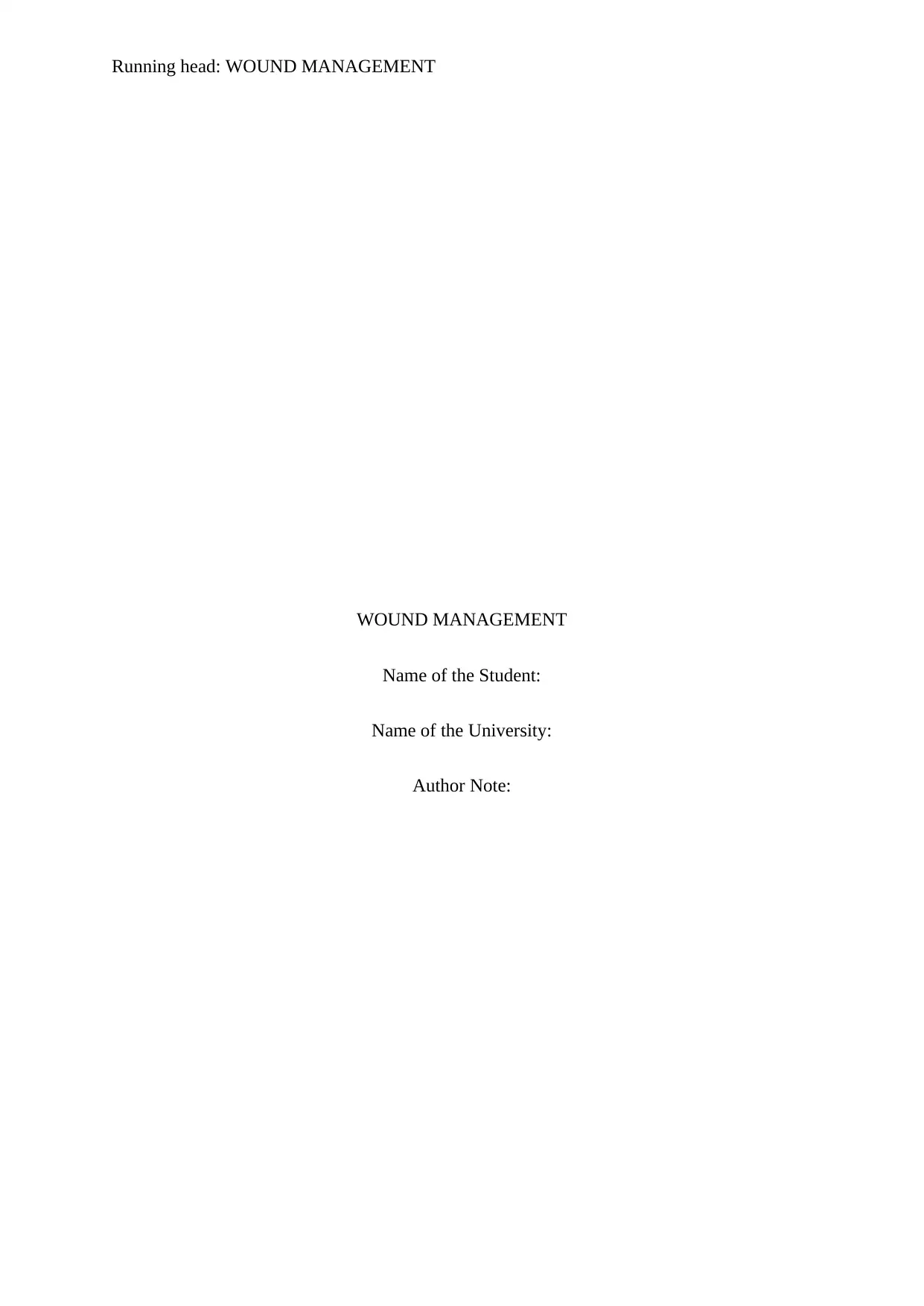
Running head: WOUND MANAGEMENT
WOUND MANAGEMENT
Name of the Student:
Name of the University:
Author Note:
WOUND MANAGEMENT
Name of the Student:
Name of the University:
Author Note:
Paraphrase This Document
Need a fresh take? Get an instant paraphrase of this document with our AI Paraphraser
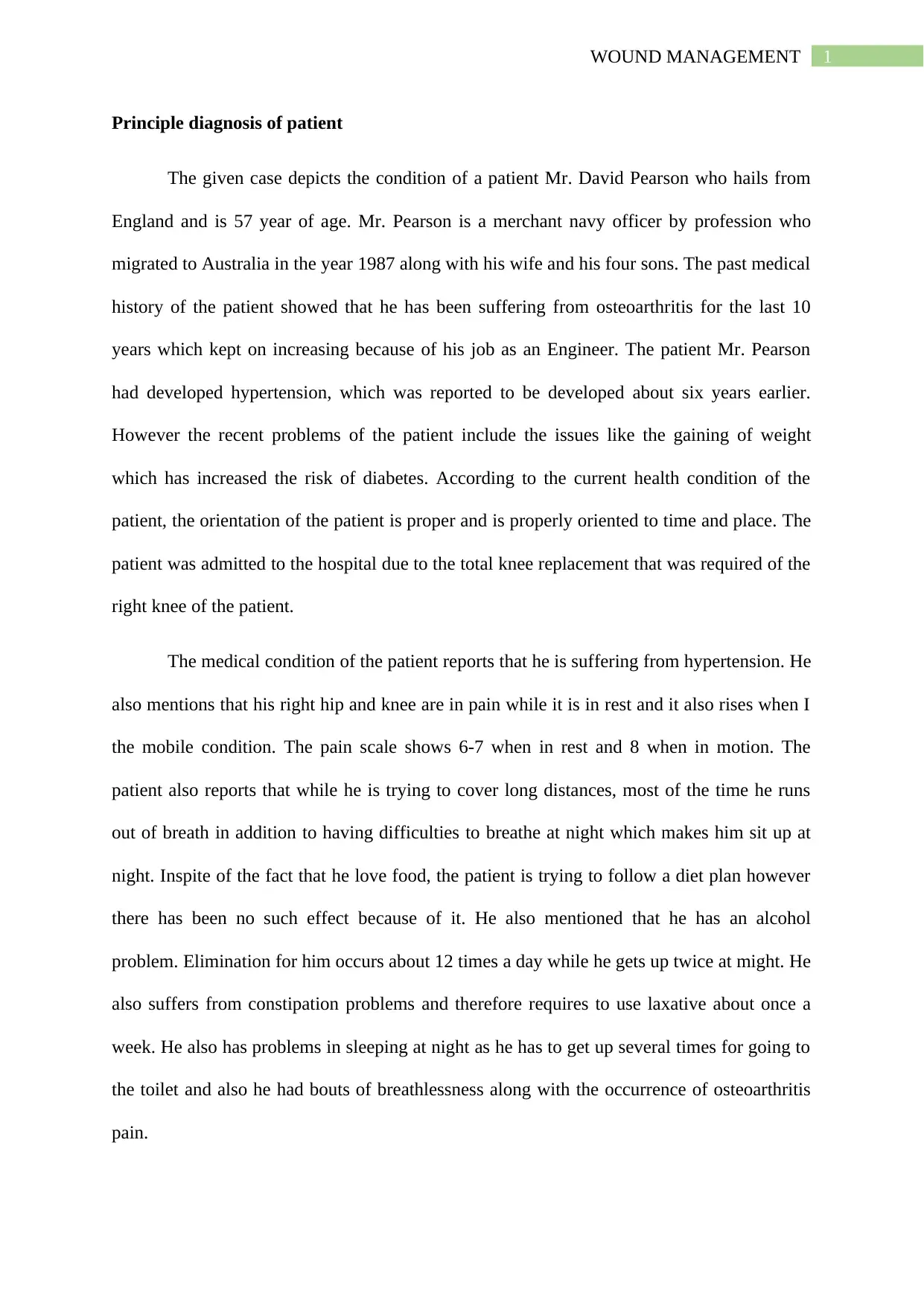
1WOUND MANAGEMENT
Principle diagnosis of patient
The given case depicts the condition of a patient Mr. David Pearson who hails from
England and is 57 year of age. Mr. Pearson is a merchant navy officer by profession who
migrated to Australia in the year 1987 along with his wife and his four sons. The past medical
history of the patient showed that he has been suffering from osteoarthritis for the last 10
years which kept on increasing because of his job as an Engineer. The patient Mr. Pearson
had developed hypertension, which was reported to be developed about six years earlier.
However the recent problems of the patient include the issues like the gaining of weight
which has increased the risk of diabetes. According to the current health condition of the
patient, the orientation of the patient is proper and is properly oriented to time and place. The
patient was admitted to the hospital due to the total knee replacement that was required of the
right knee of the patient.
The medical condition of the patient reports that he is suffering from hypertension. He
also mentions that his right hip and knee are in pain while it is in rest and it also rises when I
the mobile condition. The pain scale shows 6-7 when in rest and 8 when in motion. The
patient also reports that while he is trying to cover long distances, most of the time he runs
out of breath in addition to having difficulties to breathe at night which makes him sit up at
night. Inspite of the fact that he love food, the patient is trying to follow a diet plan however
there has been no such effect because of it. He also mentioned that he has an alcohol
problem. Elimination for him occurs about 12 times a day while he gets up twice at might. He
also suffers from constipation problems and therefore requires to use laxative about once a
week. He also has problems in sleeping at night as he has to get up several times for going to
the toilet and also he had bouts of breathlessness along with the occurrence of osteoarthritis
pain.
Principle diagnosis of patient
The given case depicts the condition of a patient Mr. David Pearson who hails from
England and is 57 year of age. Mr. Pearson is a merchant navy officer by profession who
migrated to Australia in the year 1987 along with his wife and his four sons. The past medical
history of the patient showed that he has been suffering from osteoarthritis for the last 10
years which kept on increasing because of his job as an Engineer. The patient Mr. Pearson
had developed hypertension, which was reported to be developed about six years earlier.
However the recent problems of the patient include the issues like the gaining of weight
which has increased the risk of diabetes. According to the current health condition of the
patient, the orientation of the patient is proper and is properly oriented to time and place. The
patient was admitted to the hospital due to the total knee replacement that was required of the
right knee of the patient.
The medical condition of the patient reports that he is suffering from hypertension. He
also mentions that his right hip and knee are in pain while it is in rest and it also rises when I
the mobile condition. The pain scale shows 6-7 when in rest and 8 when in motion. The
patient also reports that while he is trying to cover long distances, most of the time he runs
out of breath in addition to having difficulties to breathe at night which makes him sit up at
night. Inspite of the fact that he love food, the patient is trying to follow a diet plan however
there has been no such effect because of it. He also mentioned that he has an alcohol
problem. Elimination for him occurs about 12 times a day while he gets up twice at might. He
also suffers from constipation problems and therefore requires to use laxative about once a
week. He also has problems in sleeping at night as he has to get up several times for going to
the toilet and also he had bouts of breathlessness along with the occurrence of osteoarthritis
pain.
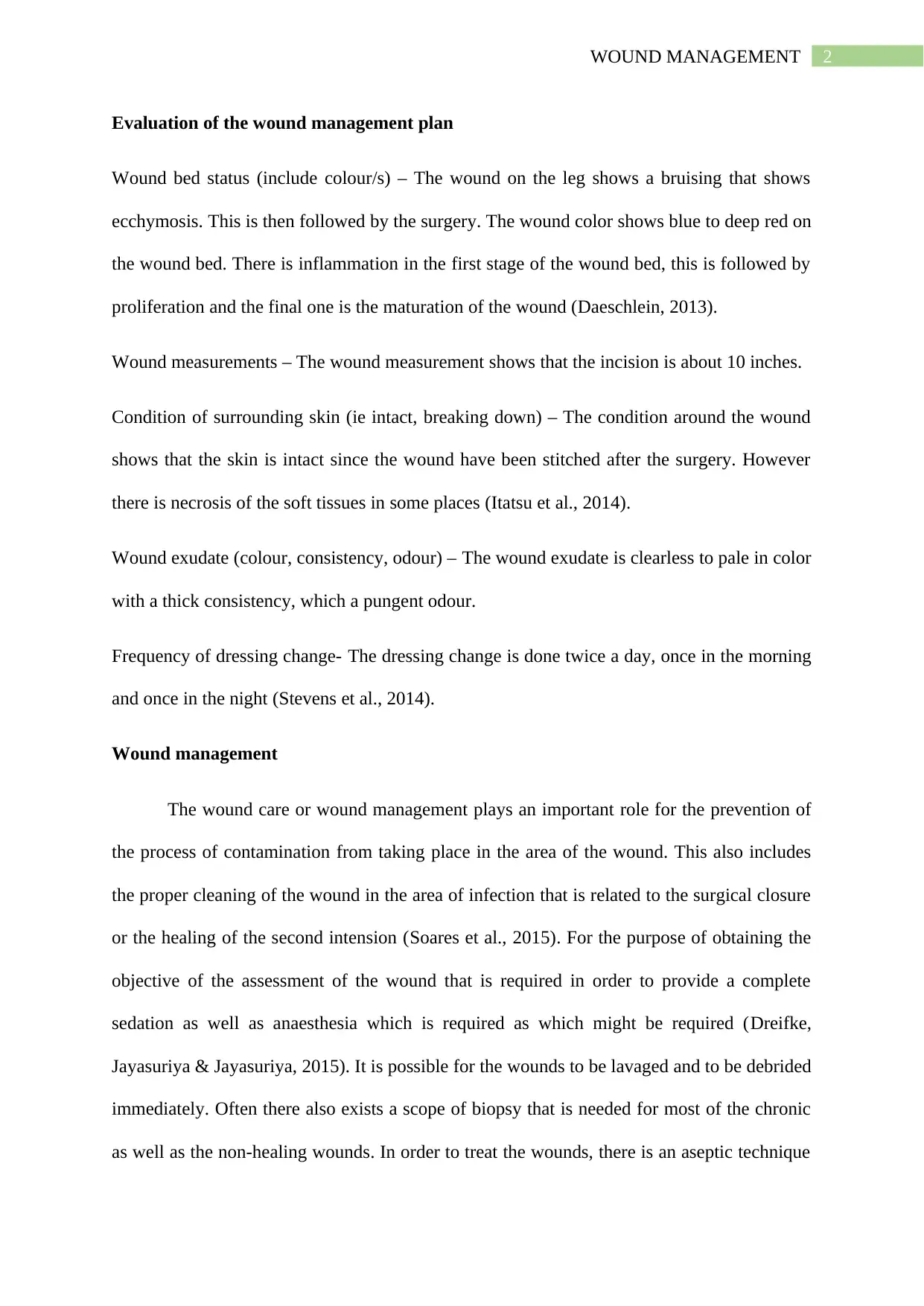
2WOUND MANAGEMENT
Evaluation of the wound management plan
Wound bed status (include colour/s) – The wound on the leg shows a bruising that shows
ecchymosis. This is then followed by the surgery. The wound color shows blue to deep red on
the wound bed. There is inflammation in the first stage of the wound bed, this is followed by
proliferation and the final one is the maturation of the wound (Daeschlein, 2013).
Wound measurements – The wound measurement shows that the incision is about 10 inches.
Condition of surrounding skin (ie intact, breaking down) – The condition around the wound
shows that the skin is intact since the wound have been stitched after the surgery. However
there is necrosis of the soft tissues in some places (Itatsu et al., 2014).
Wound exudate (colour, consistency, odour) – The wound exudate is clearless to pale in color
with a thick consistency, which a pungent odour.
Frequency of dressing change- The dressing change is done twice a day, once in the morning
and once in the night (Stevens et al., 2014).
Wound management
The wound care or wound management plays an important role for the prevention of
the process of contamination from taking place in the area of the wound. This also includes
the proper cleaning of the wound in the area of infection that is related to the surgical closure
or the healing of the second intension (Soares et al., 2015). For the purpose of obtaining the
objective of the assessment of the wound that is required in order to provide a complete
sedation as well as anaesthesia which is required as which might be required (Dreifke,
Jayasuriya & Jayasuriya, 2015). It is possible for the wounds to be lavaged and to be debrided
immediately. Often there also exists a scope of biopsy that is needed for most of the chronic
as well as the non-healing wounds. In order to treat the wounds, there is an aseptic technique
Evaluation of the wound management plan
Wound bed status (include colour/s) – The wound on the leg shows a bruising that shows
ecchymosis. This is then followed by the surgery. The wound color shows blue to deep red on
the wound bed. There is inflammation in the first stage of the wound bed, this is followed by
proliferation and the final one is the maturation of the wound (Daeschlein, 2013).
Wound measurements – The wound measurement shows that the incision is about 10 inches.
Condition of surrounding skin (ie intact, breaking down) – The condition around the wound
shows that the skin is intact since the wound have been stitched after the surgery. However
there is necrosis of the soft tissues in some places (Itatsu et al., 2014).
Wound exudate (colour, consistency, odour) – The wound exudate is clearless to pale in color
with a thick consistency, which a pungent odour.
Frequency of dressing change- The dressing change is done twice a day, once in the morning
and once in the night (Stevens et al., 2014).
Wound management
The wound care or wound management plays an important role for the prevention of
the process of contamination from taking place in the area of the wound. This also includes
the proper cleaning of the wound in the area of infection that is related to the surgical closure
or the healing of the second intension (Soares et al., 2015). For the purpose of obtaining the
objective of the assessment of the wound that is required in order to provide a complete
sedation as well as anaesthesia which is required as which might be required (Dreifke,
Jayasuriya & Jayasuriya, 2015). It is possible for the wounds to be lavaged and to be debrided
immediately. Often there also exists a scope of biopsy that is needed for most of the chronic
as well as the non-healing wounds. In order to treat the wounds, there is an aseptic technique
⊘ This is a preview!⊘
Do you want full access?
Subscribe today to unlock all pages.

Trusted by 1+ million students worldwide
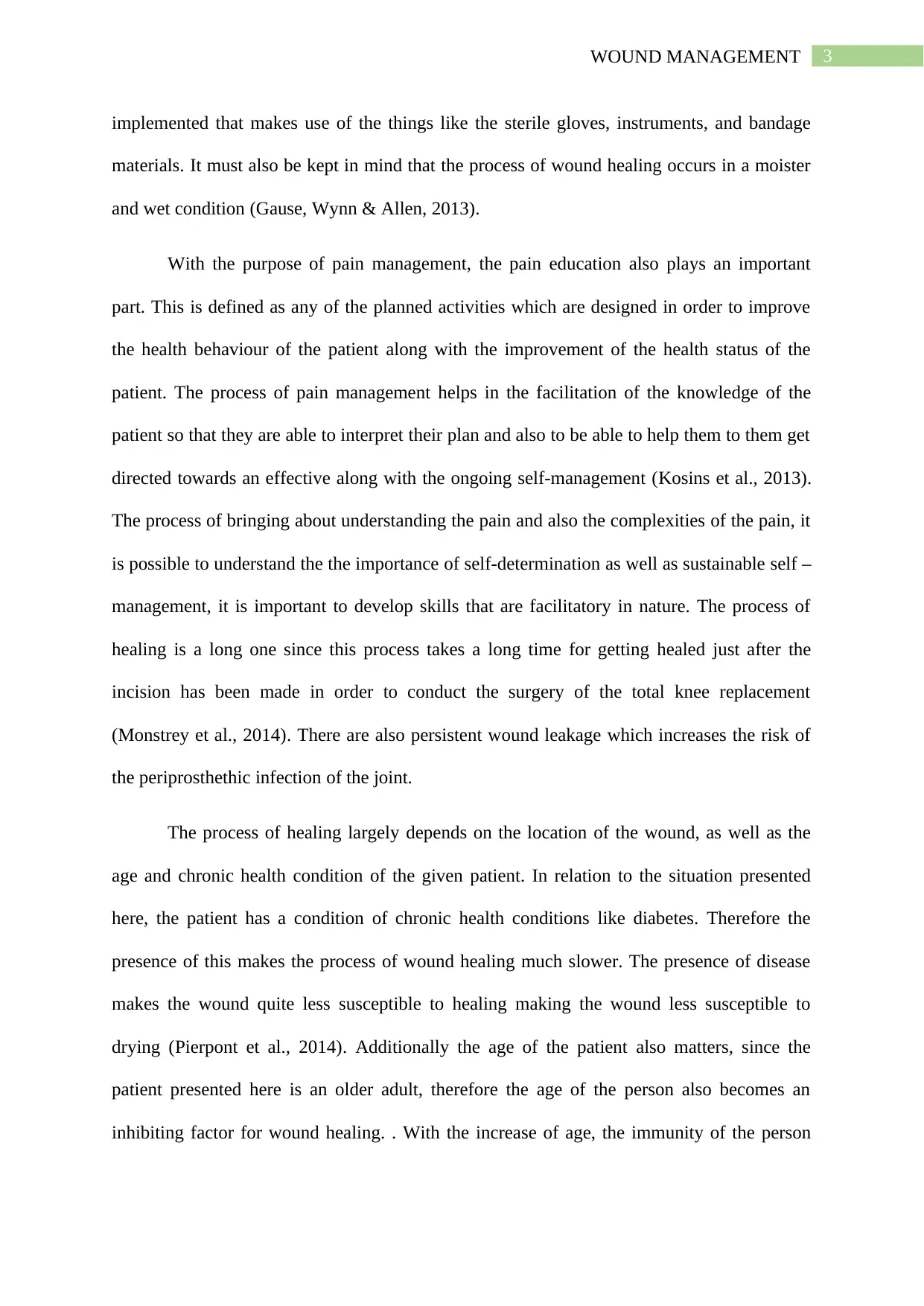
3WOUND MANAGEMENT
implemented that makes use of the things like the sterile gloves, instruments, and bandage
materials. It must also be kept in mind that the process of wound healing occurs in a moister
and wet condition (Gause, Wynn & Allen, 2013).
With the purpose of pain management, the pain education also plays an important
part. This is defined as any of the planned activities which are designed in order to improve
the health behaviour of the patient along with the improvement of the health status of the
patient. The process of pain management helps in the facilitation of the knowledge of the
patient so that they are able to interpret their plan and also to be able to help them to them get
directed towards an effective along with the ongoing self-management (Kosins et al., 2013).
The process of bringing about understanding the pain and also the complexities of the pain, it
is possible to understand the the importance of self-determination as well as sustainable self –
management, it is important to develop skills that are facilitatory in nature. The process of
healing is a long one since this process takes a long time for getting healed just after the
incision has been made in order to conduct the surgery of the total knee replacement
(Monstrey et al., 2014). There are also persistent wound leakage which increases the risk of
the periprosthethic infection of the joint.
The process of healing largely depends on the location of the wound, as well as the
age and chronic health condition of the given patient. In relation to the situation presented
here, the patient has a condition of chronic health conditions like diabetes. Therefore the
presence of this makes the process of wound healing much slower. The presence of disease
makes the wound quite less susceptible to healing making the wound less susceptible to
drying (Pierpont et al., 2014). Additionally the age of the patient also matters, since the
patient presented here is an older adult, therefore the age of the person also becomes an
inhibiting factor for wound healing. . With the increase of age, the immunity of the person
implemented that makes use of the things like the sterile gloves, instruments, and bandage
materials. It must also be kept in mind that the process of wound healing occurs in a moister
and wet condition (Gause, Wynn & Allen, 2013).
With the purpose of pain management, the pain education also plays an important
part. This is defined as any of the planned activities which are designed in order to improve
the health behaviour of the patient along with the improvement of the health status of the
patient. The process of pain management helps in the facilitation of the knowledge of the
patient so that they are able to interpret their plan and also to be able to help them to them get
directed towards an effective along with the ongoing self-management (Kosins et al., 2013).
The process of bringing about understanding the pain and also the complexities of the pain, it
is possible to understand the the importance of self-determination as well as sustainable self –
management, it is important to develop skills that are facilitatory in nature. The process of
healing is a long one since this process takes a long time for getting healed just after the
incision has been made in order to conduct the surgery of the total knee replacement
(Monstrey et al., 2014). There are also persistent wound leakage which increases the risk of
the periprosthethic infection of the joint.
The process of healing largely depends on the location of the wound, as well as the
age and chronic health condition of the given patient. In relation to the situation presented
here, the patient has a condition of chronic health conditions like diabetes. Therefore the
presence of this makes the process of wound healing much slower. The presence of disease
makes the wound quite less susceptible to healing making the wound less susceptible to
drying (Pierpont et al., 2014). Additionally the age of the patient also matters, since the
patient presented here is an older adult, therefore the age of the person also becomes an
inhibiting factor for wound healing. . With the increase of age, the immunity of the person
Paraphrase This Document
Need a fresh take? Get an instant paraphrase of this document with our AI Paraphraser
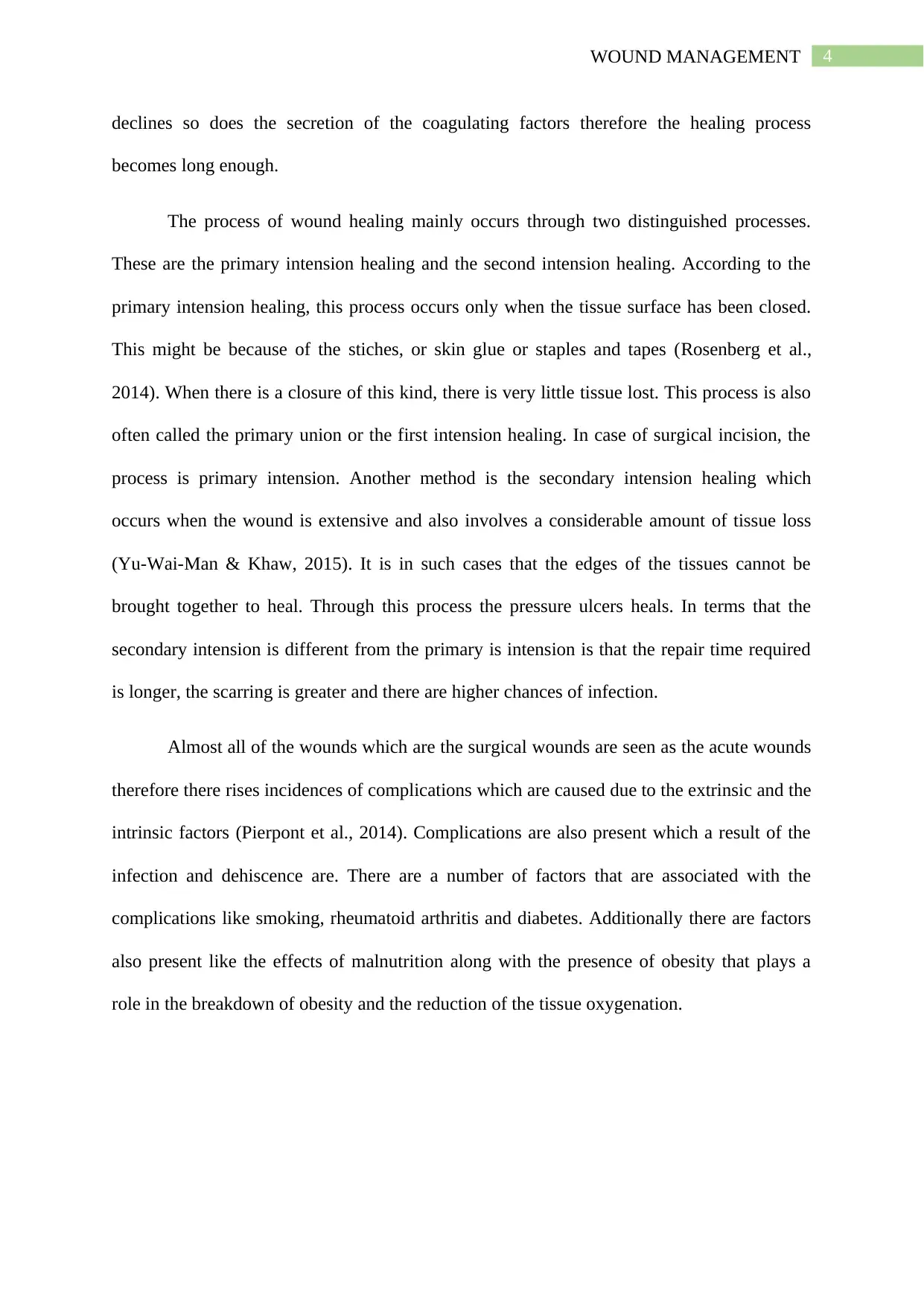
4WOUND MANAGEMENT
declines so does the secretion of the coagulating factors therefore the healing process
becomes long enough.
The process of wound healing mainly occurs through two distinguished processes.
These are the primary intension healing and the second intension healing. According to the
primary intension healing, this process occurs only when the tissue surface has been closed.
This might be because of the stiches, or skin glue or staples and tapes (Rosenberg et al.,
2014). When there is a closure of this kind, there is very little tissue lost. This process is also
often called the primary union or the first intension healing. In case of surgical incision, the
process is primary intension. Another method is the secondary intension healing which
occurs when the wound is extensive and also involves a considerable amount of tissue loss
(Yu-Wai-Man & Khaw, 2015). It is in such cases that the edges of the tissues cannot be
brought together to heal. Through this process the pressure ulcers heals. In terms that the
secondary intension is different from the primary is intension is that the repair time required
is longer, the scarring is greater and there are higher chances of infection.
Almost all of the wounds which are the surgical wounds are seen as the acute wounds
therefore there rises incidences of complications which are caused due to the extrinsic and the
intrinsic factors (Pierpont et al., 2014). Complications are also present which a result of the
infection and dehiscence are. There are a number of factors that are associated with the
complications like smoking, rheumatoid arthritis and diabetes. Additionally there are factors
also present like the effects of malnutrition along with the presence of obesity that plays a
role in the breakdown of obesity and the reduction of the tissue oxygenation.
declines so does the secretion of the coagulating factors therefore the healing process
becomes long enough.
The process of wound healing mainly occurs through two distinguished processes.
These are the primary intension healing and the second intension healing. According to the
primary intension healing, this process occurs only when the tissue surface has been closed.
This might be because of the stiches, or skin glue or staples and tapes (Rosenberg et al.,
2014). When there is a closure of this kind, there is very little tissue lost. This process is also
often called the primary union or the first intension healing. In case of surgical incision, the
process is primary intension. Another method is the secondary intension healing which
occurs when the wound is extensive and also involves a considerable amount of tissue loss
(Yu-Wai-Man & Khaw, 2015). It is in such cases that the edges of the tissues cannot be
brought together to heal. Through this process the pressure ulcers heals. In terms that the
secondary intension is different from the primary is intension is that the repair time required
is longer, the scarring is greater and there are higher chances of infection.
Almost all of the wounds which are the surgical wounds are seen as the acute wounds
therefore there rises incidences of complications which are caused due to the extrinsic and the
intrinsic factors (Pierpont et al., 2014). Complications are also present which a result of the
infection and dehiscence are. There are a number of factors that are associated with the
complications like smoking, rheumatoid arthritis and diabetes. Additionally there are factors
also present like the effects of malnutrition along with the presence of obesity that plays a
role in the breakdown of obesity and the reduction of the tissue oxygenation.
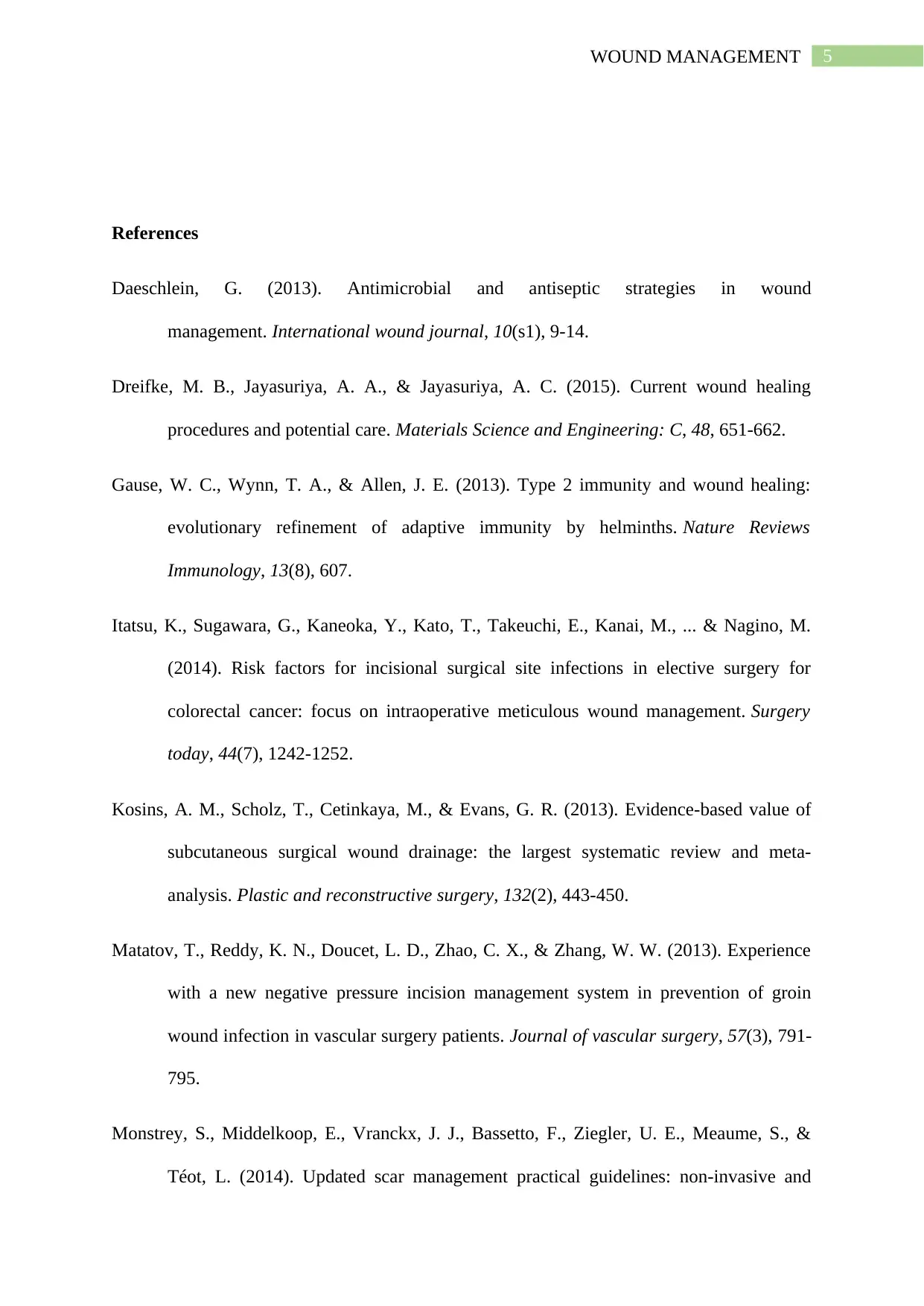
5WOUND MANAGEMENT
References
Daeschlein, G. (2013). Antimicrobial and antiseptic strategies in wound
management. International wound journal, 10(s1), 9-14.
Dreifke, M. B., Jayasuriya, A. A., & Jayasuriya, A. C. (2015). Current wound healing
procedures and potential care. Materials Science and Engineering: C, 48, 651-662.
Gause, W. C., Wynn, T. A., & Allen, J. E. (2013). Type 2 immunity and wound healing:
evolutionary refinement of adaptive immunity by helminths. Nature Reviews
Immunology, 13(8), 607.
Itatsu, K., Sugawara, G., Kaneoka, Y., Kato, T., Takeuchi, E., Kanai, M., ... & Nagino, M.
(2014). Risk factors for incisional surgical site infections in elective surgery for
colorectal cancer: focus on intraoperative meticulous wound management. Surgery
today, 44(7), 1242-1252.
Kosins, A. M., Scholz, T., Cetinkaya, M., & Evans, G. R. (2013). Evidence-based value of
subcutaneous surgical wound drainage: the largest systematic review and meta-
analysis. Plastic and reconstructive surgery, 132(2), 443-450.
Matatov, T., Reddy, K. N., Doucet, L. D., Zhao, C. X., & Zhang, W. W. (2013). Experience
with a new negative pressure incision management system in prevention of groin
wound infection in vascular surgery patients. Journal of vascular surgery, 57(3), 791-
795.
Monstrey, S., Middelkoop, E., Vranckx, J. J., Bassetto, F., Ziegler, U. E., Meaume, S., &
Téot, L. (2014). Updated scar management practical guidelines: non-invasive and
References
Daeschlein, G. (2013). Antimicrobial and antiseptic strategies in wound
management. International wound journal, 10(s1), 9-14.
Dreifke, M. B., Jayasuriya, A. A., & Jayasuriya, A. C. (2015). Current wound healing
procedures and potential care. Materials Science and Engineering: C, 48, 651-662.
Gause, W. C., Wynn, T. A., & Allen, J. E. (2013). Type 2 immunity and wound healing:
evolutionary refinement of adaptive immunity by helminths. Nature Reviews
Immunology, 13(8), 607.
Itatsu, K., Sugawara, G., Kaneoka, Y., Kato, T., Takeuchi, E., Kanai, M., ... & Nagino, M.
(2014). Risk factors for incisional surgical site infections in elective surgery for
colorectal cancer: focus on intraoperative meticulous wound management. Surgery
today, 44(7), 1242-1252.
Kosins, A. M., Scholz, T., Cetinkaya, M., & Evans, G. R. (2013). Evidence-based value of
subcutaneous surgical wound drainage: the largest systematic review and meta-
analysis. Plastic and reconstructive surgery, 132(2), 443-450.
Matatov, T., Reddy, K. N., Doucet, L. D., Zhao, C. X., & Zhang, W. W. (2013). Experience
with a new negative pressure incision management system in prevention of groin
wound infection in vascular surgery patients. Journal of vascular surgery, 57(3), 791-
795.
Monstrey, S., Middelkoop, E., Vranckx, J. J., Bassetto, F., Ziegler, U. E., Meaume, S., &
Téot, L. (2014). Updated scar management practical guidelines: non-invasive and
⊘ This is a preview!⊘
Do you want full access?
Subscribe today to unlock all pages.

Trusted by 1+ million students worldwide
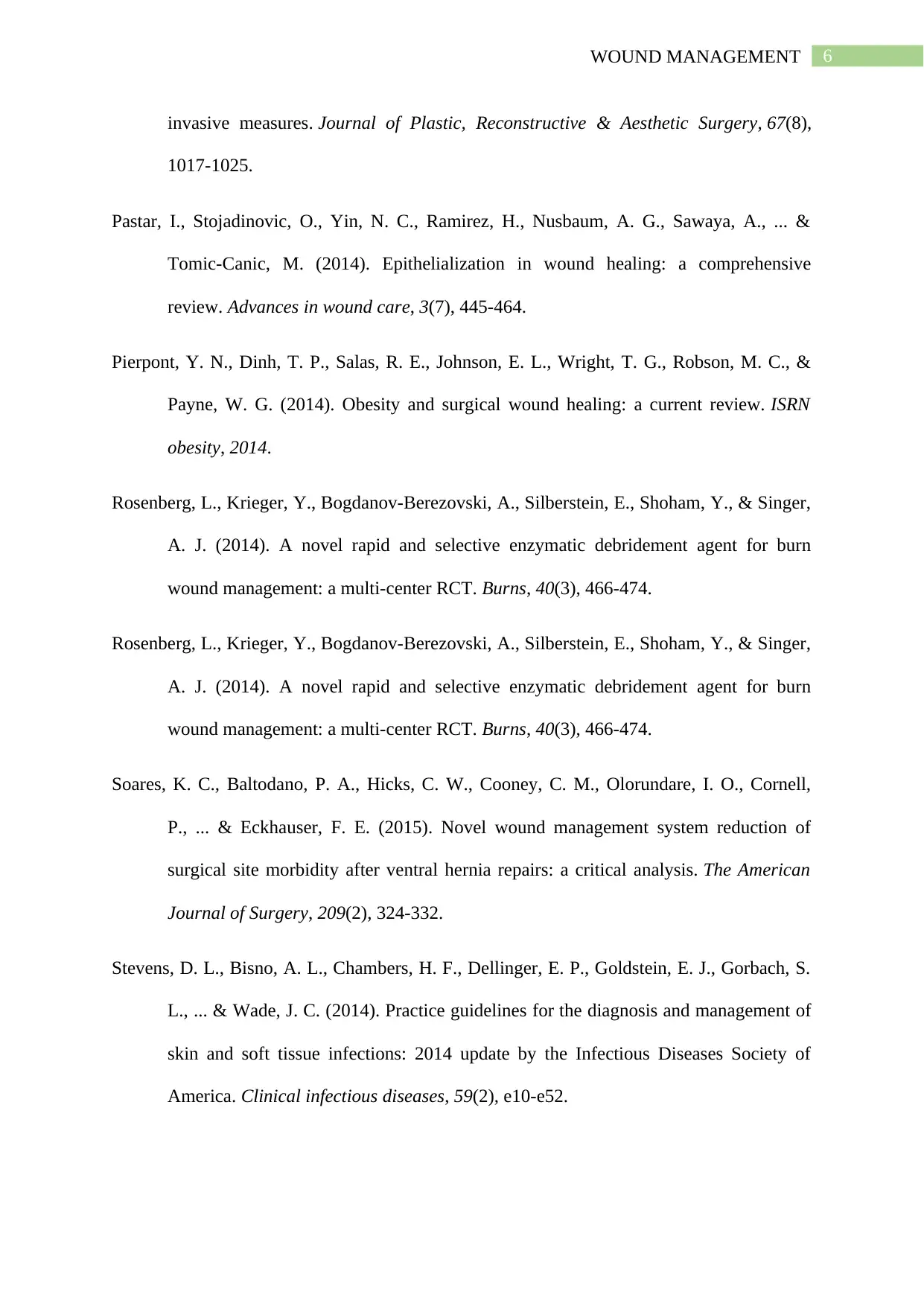
6WOUND MANAGEMENT
invasive measures. Journal of Plastic, Reconstructive & Aesthetic Surgery, 67(8),
1017-1025.
Pastar, I., Stojadinovic, O., Yin, N. C., Ramirez, H., Nusbaum, A. G., Sawaya, A., ... &
Tomic-Canic, M. (2014). Epithelialization in wound healing: a comprehensive
review. Advances in wound care, 3(7), 445-464.
Pierpont, Y. N., Dinh, T. P., Salas, R. E., Johnson, E. L., Wright, T. G., Robson, M. C., &
Payne, W. G. (2014). Obesity and surgical wound healing: a current review. ISRN
obesity, 2014.
Rosenberg, L., Krieger, Y., Bogdanov-Berezovski, A., Silberstein, E., Shoham, Y., & Singer,
A. J. (2014). A novel rapid and selective enzymatic debridement agent for burn
wound management: a multi-center RCT. Burns, 40(3), 466-474.
Rosenberg, L., Krieger, Y., Bogdanov-Berezovski, A., Silberstein, E., Shoham, Y., & Singer,
A. J. (2014). A novel rapid and selective enzymatic debridement agent for burn
wound management: a multi-center RCT. Burns, 40(3), 466-474.
Soares, K. C., Baltodano, P. A., Hicks, C. W., Cooney, C. M., Olorundare, I. O., Cornell,
P., ... & Eckhauser, F. E. (2015). Novel wound management system reduction of
surgical site morbidity after ventral hernia repairs: a critical analysis. The American
Journal of Surgery, 209(2), 324-332.
Stevens, D. L., Bisno, A. L., Chambers, H. F., Dellinger, E. P., Goldstein, E. J., Gorbach, S.
L., ... & Wade, J. C. (2014). Practice guidelines for the diagnosis and management of
skin and soft tissue infections: 2014 update by the Infectious Diseases Society of
America. Clinical infectious diseases, 59(2), e10-e52.
invasive measures. Journal of Plastic, Reconstructive & Aesthetic Surgery, 67(8),
1017-1025.
Pastar, I., Stojadinovic, O., Yin, N. C., Ramirez, H., Nusbaum, A. G., Sawaya, A., ... &
Tomic-Canic, M. (2014). Epithelialization in wound healing: a comprehensive
review. Advances in wound care, 3(7), 445-464.
Pierpont, Y. N., Dinh, T. P., Salas, R. E., Johnson, E. L., Wright, T. G., Robson, M. C., &
Payne, W. G. (2014). Obesity and surgical wound healing: a current review. ISRN
obesity, 2014.
Rosenberg, L., Krieger, Y., Bogdanov-Berezovski, A., Silberstein, E., Shoham, Y., & Singer,
A. J. (2014). A novel rapid and selective enzymatic debridement agent for burn
wound management: a multi-center RCT. Burns, 40(3), 466-474.
Rosenberg, L., Krieger, Y., Bogdanov-Berezovski, A., Silberstein, E., Shoham, Y., & Singer,
A. J. (2014). A novel rapid and selective enzymatic debridement agent for burn
wound management: a multi-center RCT. Burns, 40(3), 466-474.
Soares, K. C., Baltodano, P. A., Hicks, C. W., Cooney, C. M., Olorundare, I. O., Cornell,
P., ... & Eckhauser, F. E. (2015). Novel wound management system reduction of
surgical site morbidity after ventral hernia repairs: a critical analysis. The American
Journal of Surgery, 209(2), 324-332.
Stevens, D. L., Bisno, A. L., Chambers, H. F., Dellinger, E. P., Goldstein, E. J., Gorbach, S.
L., ... & Wade, J. C. (2014). Practice guidelines for the diagnosis and management of
skin and soft tissue infections: 2014 update by the Infectious Diseases Society of
America. Clinical infectious diseases, 59(2), e10-e52.
Paraphrase This Document
Need a fresh take? Get an instant paraphrase of this document with our AI Paraphraser
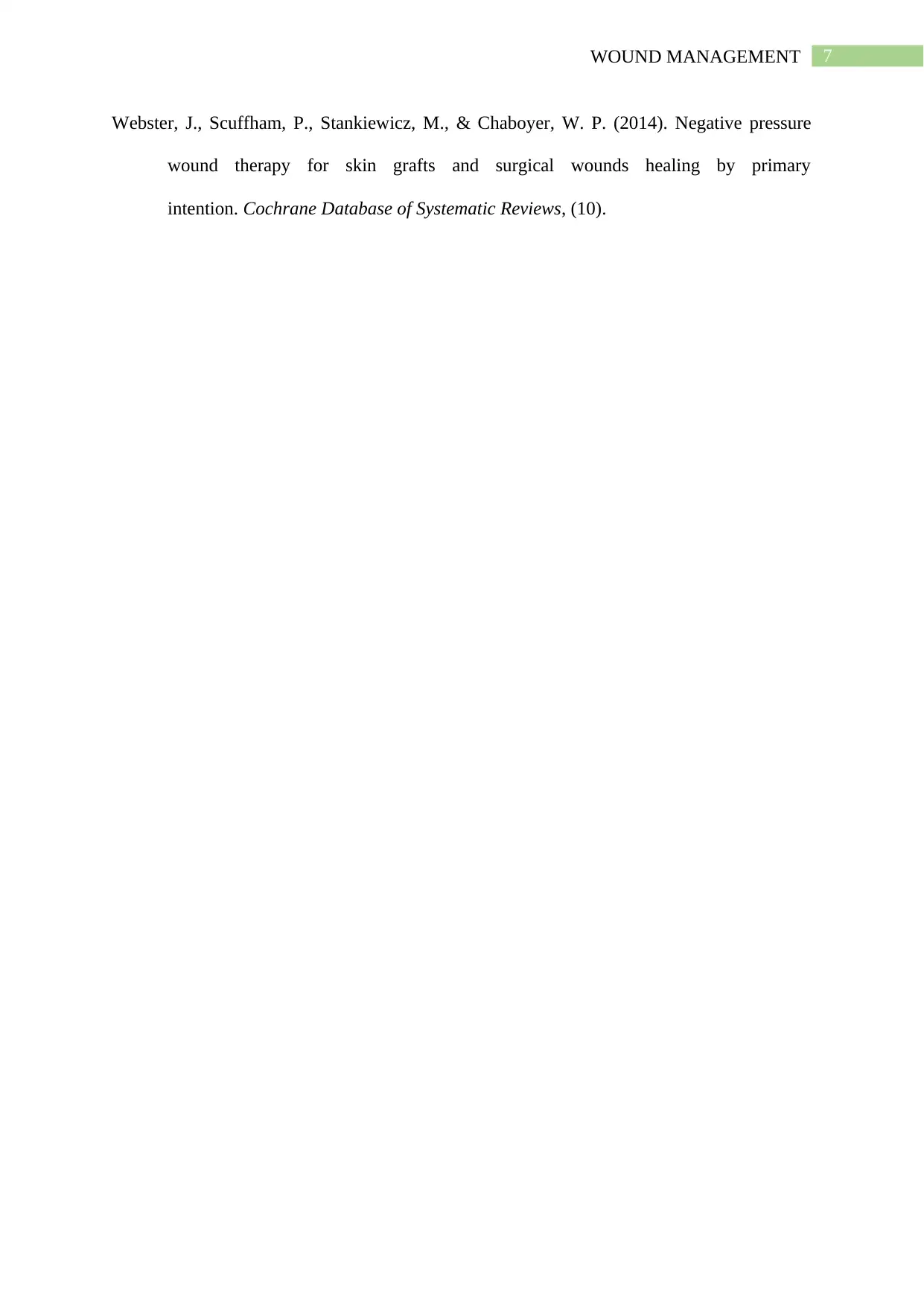
7WOUND MANAGEMENT
Webster, J., Scuffham, P., Stankiewicz, M., & Chaboyer, W. P. (2014). Negative pressure
wound therapy for skin grafts and surgical wounds healing by primary
intention. Cochrane Database of Systematic Reviews, (10).
Webster, J., Scuffham, P., Stankiewicz, M., & Chaboyer, W. P. (2014). Negative pressure
wound therapy for skin grafts and surgical wounds healing by primary
intention. Cochrane Database of Systematic Reviews, (10).
1 out of 8
Related Documents
Your All-in-One AI-Powered Toolkit for Academic Success.
+13062052269
info@desklib.com
Available 24*7 on WhatsApp / Email
![[object Object]](/_next/static/media/star-bottom.7253800d.svg)
Unlock your academic potential
Copyright © 2020–2025 A2Z Services. All Rights Reserved. Developed and managed by ZUCOL.



